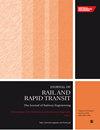Improving the mechanical performance of railway concrete sleepers using recycled materials: An experimental and numerical study
IF 2.1
4区 工程技术
Q3 ENGINEERING, CIVIL
Proceedings of the Institution of Mechanical Engineers Part F-Journal of Rail and Rapid Transit
Pub Date : 2024-05-11
DOI:10.1177/09544097241241356
引用次数: 0
Abstract
This paper explores the use of three waste materials available in vast quantities, including waste tires, glass bottles and bamboo furniture, in the manufacture of railway sleepers. Mechanical properties of recycled concrete have been studied to establish an optimal mix suitable for concrete railway sleeper manufacturing. Thus, 5%, 10%, 15% and 20% recycled rubber sands (RRS) by volume of fine aggregate are used instead of 30# and 60# mesh sizes of fine aggregate. Moreover, 20%, 40%, 60%, 80% and 100% of aggregate volume are replaced by recycled glass aggregate (RGA) particles. Furthermore, different percentages of recycled bamboo fibers (RBF) have been used as 1%, 2% and 3% by volume of concrete. According to the optimal concrete mixtures of RRS, RGA and RBF, twelve concrete railway sleepers are manufactured and tested for middle and rail seat bending strengths. Results show that ref. sleeper has almost 16% and 24% lower strengths than RGA sleeper in middle and rail seat, respectively, while ref. sleeper have higher strengths by 16% and 13%, and 18% and 7% than RRS sleeper (M60-R5) and RBF sleeper (B2) in middle and rail seat, respectively. The FEM results show that the ([Formula: see text]) of the RGA sleeper is the minimum ratio by 1.11 and 1.13 for rail seat and middle of sleeper, respectively, which is the best performance. In RBF sleeper FEM model, Bamboo fiber can only bear 5% and 8% of total stress in middle and rail seat, respectively, due to low mechanical properties of fibers.利用回收材料提高铁路混凝土枕木的机械性能:实验和数值研究
本文探讨了利用废轮胎、玻璃瓶和竹制家具等三种大量存在的废弃材料制造铁路枕木的问题。通过研究再生混凝土的机械性能,确定了适用于混凝土轨枕制造的最佳混合物。因此,按体积计算,使用 5%、10%、15% 和 20%的再生橡胶砂(RRS)代替 30# 和 60# 目尺寸的细骨料。此外,20%、40%、60%、80% 和 100%的骨料用再生玻璃骨料(RGA)颗粒代替。此外,还使用了不同比例的再生竹纤维(RBF),占混凝土体积的 1%、2% 和 3%。根据 RRS、RGA 和 RBF 的最佳混凝土混合物,制造了 12 根混凝土铁路枕木,并测试了中间和轨座的抗弯强度。结果表明,参考轨枕的中间和轨枕强度分别比 RGA 轨枕低近 16% 和 24%,而参考轨枕的中间和轨枕强度分别比 RRS 轨枕(M60-R5)和 RBF 轨枕(B2)高 16% 和 13%,以及 18% 和 7%。有限元分析结果表明,RGA轨枕的([计算公式:见正文])比值最小,在轨座和轨枕中部分别为1.11和1.13,性能最佳。在 RBF 轨枕有限元模型中,由于竹纤维的机械性能较低,其在轨枕中部和轨枕座上只能分别承受总应力的 5%和 8%。
本文章由计算机程序翻译,如有差异,请以英文原文为准。
求助全文
约1分钟内获得全文
求助全文
来源期刊

CiteScore
4.80
自引率
10.00%
发文量
91
审稿时长
7 months
期刊介绍:
The Journal of Rail and Rapid Transit is devoted to engineering in its widest interpretation applicable to rail and rapid transit. The Journal aims to promote sharing of technical knowledge, ideas and experience between engineers and researchers working in the railway field.
 求助内容:
求助内容: 应助结果提醒方式:
应助结果提醒方式:


